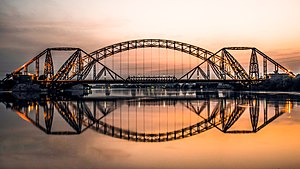Ayub Bridge ایوب پل | |
|---|---|
 Ayub Bridge | |
| Coordinates | 27°41′38″N 68°53′18″E / 27.693788°N 68.888217°E |
| Carries | Railway |
| Crosses | River Indus |
| Locale | Sukkur |
| Characteristics | |
| Design | Dorman Long of Middlesbrough, England |
| Material | Iron – Steel |
| Total length | 806 feet |
| Height | 247 feet |
| Longest span | 806 feet (246 m) |
| Rail characteristics | |
| Track gauge | 1676 |
| History | |
| Designer | David B Steinman |
| Construction start | Nov 1959 |
| Construction end | May 1962 |
| Statistics | |
| Daily traffic | Railway traffic |
| Location | |
 | |

Ayub Bridge (Sindhi: ايوب پل; Urdu: ایوب پل ), named after Field Marshal Mohammad Ayub Khan (President of Pakistan), is a railway bridge over the Indus River between Rohri and Sukkur in Sindh province, Pakistan. The bridge is about 806 feet long, 247 feet high and cost Rs21.6 million. It has served the city for 50 years by providing a strong link for rail traffic between Sukkur and Rohri. Before this, Lansdowne Bridge was the railway link between Sukkur and Rohri. The foundation stone of this steel arch bridge was laid on 9 December 1960 and inaugurated by President Muhammad Ayub Khan on 6 May 1962. The consulting engineer was David B. Steinman.[1] The Ayub Bridge became the world's third longest railway arch span and the first railway bridge in the world to be slung on coiled wire rope suspenders.

- ^ Memon, Sarfaraz (7 May 2012). "British engineering: Ayub Bridge turns 50". The Express Tribune. Retrieved 10 January 2013.